Tag: OHC
Announcing the Oral History Center’s new director, Paul Burnett
Congratulations to Paul Burnett!
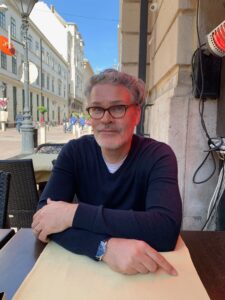
We are pleased to announce that historian Paul Burnett has been appointed the Charles B. Faulhaber director of the Oral History Center following a national search. Paul joined the OHC staff in 2013 and has focused on science, engineering, and UC Berkeley history. He has published a number of academic articles, and has developed and directed large-scale oral history projects on economics, paleontology, Czech physics, the San Francisco Opera, and engineering, among other subjects. Paul has also worked to reach a wider public with a series of online articles for the UC Library blog, a curriculum for high schools on epidemics in history, and podcasts on the early years of the HIV/AIDS epidemic and on the rise of Silicon Valley.
Prior to joining the Oral History Center, Paul was an assistant professor with the Science and Technology Studies Programme at St. Thomas University in New Brunswick, Canada. Before that, Paul researched and produced museum exhibits for the American Philosophical Society in Philadelphia. He completed his PhD at the Department of History and Sociology of Science at the University of Pennsylvania in 2008, where he developed his research on the politics of expertise — how scientists and experts of all kinds establish their credibility, and how people choose between different kinds of expertise to try to solve complex social, political, scientific, and technical problems.
Paul is looking forward to further developing the OHC’s collection, to making the archive’s audio and video more accessible to the public, especially to students in high schools and universities, and to promoting the interpretive work of Center historians.
Please join us in welcoming Paul Burnett to his new role.
The Roots of the Oral History Center
by Charles Faulhaber, Interim Director of The Bancroft Library
As we bid farewell to 2021, I’ve been thinking about the power of first-person accounts and the meaning of oral history within The Bancroft Library’s collections. Bancroft’s Oral History Center was founded in 1953 by Robert Gordon Sproul, President of the University of California, as the Regional Oral History Office, “regional” because there was one at Berkeley for northern California and one at UCLA for southern California.
In fact, however, Bancroft’s oral history roots lie much deeper than that. As early as the 1860s, San Francisco bookdealer Hubert Howe Bancroft, the founder of The Bancroft Library, was traveling extensively up and down the Pacific Coast and back to the East Coast in order to record “dictations,” his interviews with the men, and some women, who had made the West their home. In Utah he interviewed Mormon leaders while his wife, Matilda Griffings Bancroft, interviewed their wives. On a trip to Pennsylvania he interviewed John Sutter, bitter over the failure of the federal government to compensate him for the loss of his extensive land grants in the gold-rich foothills of the Sierra Nevada.
Later, as Bancroft’s plans for a monumental history of California and the American West—eventually 39 massive volumes—crystallized, he hired staff to record dictations with the Californios, the Spaniards and Mexicans who had colonized Alta California from 1769 onward, men like Mariano Guadalupe Vallejo, the last Mexican commandant of the Presidio in San Francisco, as well as with native Americans, like Isidora Filomena, the wife of chief Solano of the Suisun tribe.
Bancroft believed that these contemporaneous oral accounts provided an essential complement to the written sources in his library, which he eventually sold to the University of California in 1905. This is the same philosophy that informs the activities of the Oral History Center today. The thousands of oral histories that have been recorded in the almost seventy years since the Center was founded inform and enrich the printed and manuscript documentation collected by Bancroft’s curators.
Thus the series of oral histories of Japanese Americans who were incarcerated during World War II has proved to be a fundamental resource for Bancroft’s current exhibition, “UPROOTED: The Incarceration of Japanese Americans,” which also draws from Bancroft’s extensive collection of documents, photographs, and family and personal papers. This exhibition commemorates the 80th anniversary of President Franklin D. Roosevelt’s Executive Order 9066, which ordered the incarceration of all Japanese Americans on the West Coast, including American citizens, some 113,000 individuals.
I invite you to visit this powerful exhibit at The Bancroft Library Gallery when it re-opens briefly from January 10-21 and then again from February 17, 2022 through June 30, 2022, and hear first-hand the words of the uprooted, preserved for posterity through oral history.
The Oral History Center of The Bancroft Library has interviews on just about every topic imaginable. You can find the interviews mentioned here and all our oral histories from the search feature on our home page. Search by name, keyword, and several other criteria. The Oral History Center preserves voices of people from all walks of life, with varying political perspectives, national origins, and ethnic backgrounds. We are committed to open access and our oral histories and interpretive materials are available online at no cost to scholars and the public.
Looking Back: Oral History Center Staff Reflects on 2021
As we transition from 2021 to 2022, the Oral History Center staff reflects on a year that moved both fast and slow and was full of change, yet much of the same. I asked our team to share their highlights from the past year. Join us as we look back on the moments in which our team found hope, joy, and inspiration in over the past twelve months. — Martin Meeker, OHC Director
“This year, we received so much good news about new endeavors, and projects that had been on hold in 2020 came roaring back. I am ever grateful to all our project partners who saw the potential of these remote oral history projects, and for narrators who were willing to be flexible and try new technologies for recording interviews. One such project is the Save Mount Diablo Oral History Project. Shanna Farrell and I have been working on this project to document the history of this Contra Costa County land trust organization in celebration of its fiftieth anniversary on December 7, 2021. We will be turning these important interviews into podcast episodes of The Berkeley Remix, so stay tuned for more to come on this project!”
–Amanda Tewes, Interviewer/Historian
“2021 has been a remarkable year for the Oral History Center, and I am as thankful as ever to be a part of such a uniquely talented organization. I listened on as interviewers conducted more oral histories than ever through a carefully planned combination of remote and in-person interviews. I marveled at my good fortune to work with a talented team of student workers who process, preserve, and edit our video oral histories in a variety of formats. We continued our rich collaboration with University of Southern California MMLIS interns to enhance access via improved metadata for oral histories from our archives. Student workers and interns provide significant contributions to the Oral History Center year in and year out, but their navigating academics, work, and daily life through the challenges of a pandemic was especially inspiring. Thanks are due to the contributions of recent graduates Yarelly Bonilla-Leon and Abigail Jaquez; continuing mentors Max Afifi, Tasnima Naoshin, and Lydia Qu; and newest team members Mina Choi and Vivien Huerta-Guimont. I am excited to see what the Oral History Center will accomplish in 2022!”
–David Dunham, Operations Manager and Project Manager, Rosie the Riveter / WWII Home Front Oral History Project
“This year I’d like to highlight the stellar work of the undergraduate student employees on the editorial team. They maintained their professionalism and high-quality work throughout the pandemic and I’m impressed with how much they’ve been able to accomplish. A big thank you to my team of student editors, spring graduates Jordan Harris and Ricky Noel; current employees Mollie Appel-Turner, Adam Hagen, Ashley Sangyou Kim, and Lauren Sheehan-Clark; and research assistants Deborah Qu and Serena Ingalls. The student editors serve critical functions in our oral history production, analyzing entire transcripts to write discursive tables of contents, entering interviewee comments, editing front matter, and writing abstracts. They do the work of professional editors and we would not be able to keep up our pace of interviews without them. The research assistants conduct research for our social media outreach and other projects. Excellent writers in their own right, the student employees also research and write articles highlighting individuals and projects in our vast archive. These contributions have enabled us to better share the wealth of our collection with scholars and the public. You can read about their experiences working remotely during shelter-in-place in this newsletter, and keep an eye out for their insightful articles in future editions.”
–Jill Schlessinger, Communications/Managing Editor
“In our second pandemic year, we continued some remote interviewing while resuming our traditional in-person recording for certain projects. Although there was a period of adjustment, and though there is still no substitute for sitting together in a room to share a story, the fact is that we now interview people across the country and around the world in a way that would not have been possible just a decade ago. I’m grateful for in-person interviewing, but I’m also thankful for the opportunities to do remote interviewing and to do more online, interactive teaching. Among my 2021 interviews, there are too many highlights to name, but what stays with me is the description of a formative moment, the life experiences that were rich and meaningful, the way a crescendo of a voice raised in excitement brings a point home, or the way a pause gives space and time to let the meaning of what has been said sink in.”
–Paul Burnett, Interviewer/Historian
“For me, “home” has been an important theme throughout 2021, particular as this year ends. Home can mean different things to different folks, but it often involves the people and places with the greatest mutual influences in our lives. My oral history interviews in 2021, which totaled nearly 100 recorded hours with a mix of academic, political, and environmental actors, included Zoom calls beamed into a narrator’s home as well as face-to-face recordings physically inside their homes. Whether conducted online or in person, our narrators invite us into their homes in various ways. Narrators often share stories of where they lived and with whom throughout their childhoods and in their personal lives. These memories of “home,” as it’s evolved over time, are replete with rich and complicated human and more-than-human relations that recall moments of happiness and heartbreak, dissonance and discovery, and emotions sometimes unresolved or rarely recalled but still surprisingly powerful. The stories a narrator chooses to tell, or not tell, can say a great deal about their sense of home, as well as who, what, or where gets included there for them at different times. In 2021, both my narrators and I also experienced how the ongoing COVID19 pandemic has reified and refracted the role that home plays in our lives. The blessing of vaccines helped many of us expand—at least for a moment or two—the realms we’ve called home since the pandemic began. Additionally, during these final months of 2021, my family and I experienced the blessing (and complications) of purchasing and moving into our own first home. As the year ends, I remain deeply grateful for the privilege and responsibility of joining narrators in their homes, of hearing about the evolving influences that home has played in their lives, and also reconciling and reconstituting the many meanings of home in my own life.”
–Roger Eardley-Pryor, Interviewer/Historian
“There’s a lot to celebrate as 2021 draws to a close. I’ve been able to work on new oral histories and continue existing projects with the help of remote recording technology. I’ll be forever grateful that the OHC has been able to adapt our model using Zoom so that some semblance of normalcy persists through the continual waves of uncertainty. I was able to interview people I wouldn’t have otherwise been able to for ongoing projects like the East Bay Regional Park District oral histories and start the pre-interview process for our newly funded project about Japanese American Intergenerational Narratives. As we enter 2022, we’ll likely have a mix of in-person and remote interviews, but I (and my narrators!) appreciate the flexibility and options that are now integrated into our interviewing process. Also with the help of Zoom, we were able to continue our Introductory Workshop and Advanced Summer Institute, so that we could train those who wish to enhance their oral history skills. Lastly, I published my second book, A Good Drink: In Pursuit of Sustainable Spirits, and was able to do a number of virtual events, including a roundtable with The Bancroft Library. Lots to celebrate, indeed! Here’s to a healthy, productive, and successful 2022 with much more to toast!”
–Shanna Farrell, Interviewer/Historian
“After a tumultuous 2020, the past year ushered in much to celebrate and be grateful for at the OHC. Thanks to the resilience of many narrators, projects new and old were put into the books. The Yale Agrarian Studies Project, featuring the oral histories of famed social scientist James C. Scott and affiliates of his Agrarian Studies Program were officially released in September. The Chicana/o Studies Oral History Project, which was launched in 2017, also finally reached the finish line. Composed of in-depth interviews with nearly two dozen scholars who played a vital role in the field’s formation and development, the project will be released in early 2022. Our partnership with the California State Archives also grew to new heights this past year. Building on the oral history we conducted with Governor Jerry Brown, we initiated a new project on Governor Schwarzenegger’s signature climate change program: The Global Warming Solutions Act (AB32). We were also able to conduct a new round of interviews for the State Government Oral History Program—a program I’m happy to report has been given a multi-year renewal by the state legislature. Lastly, I completed a short documentary film on Japanese American Redress with Emi Kuboyama at Stanford University, who is also an alumni of the OHC Summer Institute. The film features oral histories we conducted with community leaders and former staff of the Office of Redress Administration. Thanks to a grant from the Takahashi Foundation, we will be reediting the film in the coming year for classroom and television use. Here’s to a productive 2021 and an even better 2022.”
–Todd Holmes, Interviewer/Historian
OHC’s November 2021 Director’s Guest Column: “Power, Empathy, and Respect in Oral History” by Paul Burnett
“So oral history is interviewing.” I get this a lot from people who are trying to understand what I do for a living. Yes, the interview is the primary way in which we gather our historical data, our stories. When people think of interviews in general, however, they might think of the police interrogation, the oral examination in schools, the journalist’s scoop, even an anthropologist’s study of a community, amongst other examples. Near the end of his life, philosopher Michel Foucault was hoping to do a large research project on the interview and the examination as sites of power relations. He could not have been more astute. In each of the examples above, control rests almost completely with the interviewer. The interviewers extract information from the narrator for their own purposes, often without consideration of the interests of the narrator, and sometimes directly against their interests. Sometimes narrators are allowed to see the resulting work; often they are not consulted.
By contrast, oral history as a disciplinary academic practice and as a social movement begins and ends with the problem of power. It’s not that we can get rid of power; power is interwoven through our relationships. Oral history methods acknowledge power relations as a problem to be managed, helping to ensure that the narrators tell the stories they want to tell. We begin with a process of informed consent, so that narrators know what to expect from beginning to end, and that they have the power to withdraw from the work at any moment, even after the project is finished. We then engage in a period of planning and research. Although a spontaneous, cold interview might seem more authentic, what happens in those cases is that the narrator is often at sea in their memories, their real-time decision-making about how to present themselves, and their anxiety about which stories to tell, in how much detail, and with what words. And then we are right back to the problem of the interviewer controlling the scene. By collaboratively planning in advance, the narrator and interviewer build a bond of trust and a plan around the nature of the storytelling.
And when the interview happens, we can both relax, and that’s where it becomes spontaneous. I call it “planned spontaneity,” with a heavy debt to Miles Davis’ approach to “controlled freedom” in jazz performance. Telling a story is like singing; it is singing. It can be an emotional performance of your deepest truths. I’d be tempted to say that the interviewer is the impresario in this metaphor, arranging things so that the narrator’s story shines. But my ideal role would be to serve as both the room and the audience, to let the narrator hear their own voice reflected from the back of the hall, and to see and sense the audience’s engagement with the performance. Ask any singer, and that’s what they need for a good performance; they need feedback from the audience and to hear their own voices.
That’s why, during the interview, I “read back” what I’m hearing periodically to give real-time feedback. But we also transcribe the interview so that the narrator can review what they have said and decide if that is the final form of the story, making changes as needed. Then we ask them to sign off on the finished product, with some guarantee of access to the narrator and their communities. All of these practices together form a set of protections that maximize the narrator’s power in forming, telling, and preserving stories for the future.
The problem of power might be mitigated by this set of practices, but power is always unfinished business. There is the history of the interview itself, whose reputation for extraction, exploitation, and manipulation is not lost on many communities. There is the university, a site of state, political, and economic power, and the authority to include or exclude that hangs over the interview. Anthropologist Michel Rolph-Trouillot wrote about the ways in which the decision about what gets included in archives is the first and perhaps most important violence done to history. Narrators and interviewers come to the interview within multiple, overlapping sets of power relations, exclusions, and hierarchies that threaten to distort and even block trustful communication.
For the interviewer’s part, there are two basic orientations that help with – but do not solve – these problems. The first is empathy. I have interviewed a lot of powerful people, people who might seem from a distance invulnerable, privileged, at ease. I hate to sound obvious, but everyone has experienced exclusion, denigration, and trauma of some kind in their lives, often of many kinds. Sometimes exclusion is a source of pride; but it is most often a source of pain. I have a lot of power and privilege, but I can tap into experiences of the exercise of arbitrary authority, exclusions, bullying, violence and trauma in order to attempt to connect to those who have experienced far greater violence, who have lived lifetimes inside social structures of exclusion and trauma. But if we amplify voices of the excluded, we have to understand that connecting and collecting can too easily end up as claiming and taking.
Empathy is only one part of it. That assumption of some kind of access to another’s experience is another problem of power and privilege. Interviewers also have to begin with the assumption that vast oceans of human experience elude them. Research can help, but a fundamental orientation of humility and respect is required to establish a bond of trust with a narrator. Is there some core of human experience that we all share? Of course. But history shunts us all into patterns of human experience that are both radically different and arranged in a long list of intersectional hierarchies of arbitrary value – race, class, gender identity and orientation, citizenship, disability, body politics, and surely more structures which we as a society have yet to recognize, never mind address. All of that comes into play in the interview encounter, and it may determine whether the interview happens at all. A humility before this pageant of exclusion is the necessary companion to empathy.
What I’m presenting here isn’t new. The oral history community has been wrestling with these questions for a long time, especially with its frequently expressed commitment to using oral history to explore those hierarchies of value, to shine a light on and validate the experiences of the excluded and the othered. Although I’m an oral historian, I’m also a historian of science. One of the things I’m interested in is how disciplines define themselves. One of the patterns about knowers in a discipline is that they are sometimes poor interpreters of their own origins and practices. Researchers often have the hardest time seeing the very spot from which they observe. It may be precisely because of their commitment to reflexivity that oral historians may not be able to see, or perhaps hear, these challenges. We check our audio equipment, but sometimes we don’t check how we are listening, or whether we’re able to hear something at all. Our most important listening equipment is between our ears, or maybe inside our chests, and limited by our lived experience and frames of reference. What we need to continually re-examine and affirm is our commitment to empathy, humility, and trust in our work.
August 2021 OHC Book Club Pick: Let’s Talk About Hard Things by Anna Sale
Good news for all of you book club fans out there! The Oral History Center is pleased to announce the pick for our Summer 2021 Book Club: Let’s Talk About Hard Things by Death, Sex & Money podcast host, Anna Sale. Anna is also a podcast and audio instructor with the UC Berkeley Graduate School of Journalism’s Advanced Media Institute.
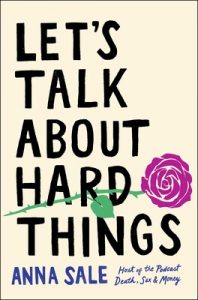
And there’s more! Anna Sale will be joining us for our virtual book club discussion!
We’ll be welcoming Anna as our special guest on Tuesday, August 10, 2021 from 2-3pm PST via Zoom.
If you’d like to join, please send an RSVP to Shanna Farrell at sfarrell@library.berkeley.edu. Once you’ve RSVP’d, Shanna will send you the Zoom information.
You can find Let’s Talk About Hard Things online, at your local bookstore, and at your local library. We look forward to seeing you in August!
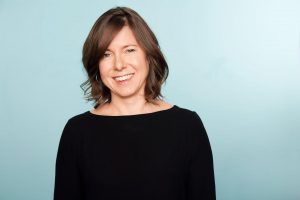
Crip Camp and Judy Heumann: Studies in Movement Snapshots
by Annabelle Long
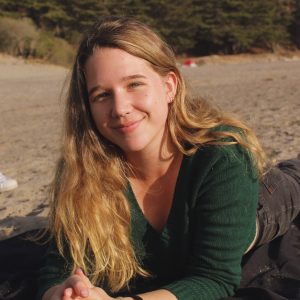
Annabelle Long is an Undergraduate Research Apprentice at the Oral History Center. She worked with Shanna Farrell during the Spring ’21 semester. Annabelle is a third-year History and Creative Writing student from Sacramento. She works as a conduct caseworker in the Student Advocate’s Office and enjoys going on long walks in Berkeley. You can find her on Twitter @annabelllekl.
I watched the 2020 documentary Crip Camp to get a sense of Judy Heumann, the disability rights icon and architect of a movement that created a more accessible world. I had only recently read her oral history, conducted by UC Berkeley’s Oral History Center, and I was eager to learn more about the woman behind the words on the page. When she is first shown in the film, she is doing what I’ve learned that she does best: leading a group. She has a big voice and a bigger grin, and talks campers through their options for dinner later in the week. She’s already thought it through—she considered veal parmesan, but found the veal to be too expensive, so next on her list is lasagna, the suggestion of which elicits both cheers and groans from the crowd. She offers everyone a chance to make their case, and then takes a vote. Lasagna wins—barely. This vote, in its consequences, probably meant very little to Judy and very little to everyone else. But in my mind, it makes one thing clear: Judy didn’t make any decisions without considering and consulting the group. She cared what people had to say, and she listened. And so campers had lasagna, and eventually, thanks to her activism, disabled Americans had laws to protect them.
Crimp Camp provides a snapshot of the disability rights movement through the lens of Camp Jened, a summer camp for disabled children and teenagers that opened in upstate New York in 1951. Each summer, about 120 campers moved in for four to eight weeks. The camp, despite often being credited with changing the lives of its campers, had immense financial struggles and closed its doors in 1977, leaving its legacy in the hands of the many campers who passed through. Judy contracted polio and became paralyzed at 18 months old, and for every summer from ages 9 to 18, she was one of those campers. She credited her time at Jened with shaping her approach to activism and life generally.
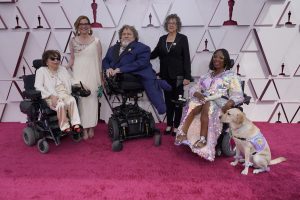
Jened resembles the woodsy summer camps of my childhood, but it had more of a Summer of Love aura about it—the rec room was boisterous and the softball games were passionately played, but at Jened, counselors were hippies, campers fell in love, and the bunkrooms and mess halls overflowed with eager conversations about the state of disability rights and the world. It was in those conversations, Judy would go on to say, that she learned to listen to a group, lead a group, and speak as a part of a group. To Judy and the other campers, Jened was more than a camp: it was a place to be fully and truly oneself, a place to try out new politics, and often, a place to meet close friends and lovers (Judy even said she never dated outside of camp). It almost seemed sacred.
Jened is both a moment and an enduring feature in the history of the disability rights movement, and Crip Camp seeks to understand it as both: as a physical place, where people gathered and grew, and as a concept, a memory and idea that endured well beyond the summers it operated. Oral history, as a practice, seeks to accomplish something similar. It draws on memories of particular moments, the feelings that make something worth remembering, and unites those memories with broader historical narratives to give a complete picture of a life and a time. But I can’t help but wonder—what does it mean when a story continues after the taping is done? When the end of the recorded narrative turns out to be the midpoint of a real and full life?
Judy Heumann’s oral history focuses on her time UC Berkeley, where she received her master’s in Public Health, and the 504 sit-in of 1977, which she was critical in organizing. For 25 days, Judy and well over 100 disabled people occupied the San Francisco office of the United States Department of Health, Education, and Welfare and demanded enforcement of Section 504 of the Rehabilitation Act of 1973, which stated that no institution receiving federal funding could exclude people on the basis of their disability. Judy’s activism in 1972 was critical to getting Section 504 written in the first place, and she and other disabled people were tired of it being completely unenforced—schools, cities, and buildings were still inaccessible despite the law’s promise. Schools lacked elevators to allow disabled students to get to their classrooms; sidewalks lacked defined dips in the corners and thus often forced wheelchair users to take inconvenient, circuitous routes to their destinations or left them stranded. In response, disabled people occupied government buildings across the country in protest. The San Francisco demonstration was the longest lasting and arguably the most successful, largely thanks to the motivating force that was Judy Heumann.
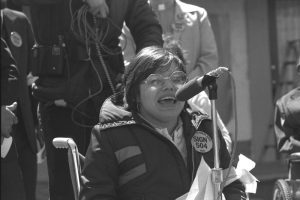
Judy Heumann
In Crip Camp, Corbett O’Toole, a disabled activist and one of Judy’s contemporaries at the Center for Independent Living at UC Berkeley, said that “we were more scared of disappointing Judy Heumann than we ever were of the FBI or police department arresting us.” This was because Judy served as the central organizing force of the occupation—she held down the fort, ensured people’s needs were met (no easy task when many occupiers required around-the-clock physical assistance), and negotiated with government figures to advance the cause. I’d be scared to disappoint her, too.
There’s no debate about her status as an organizing powerhouse. In the early days of the disability rights movement, everyone in her orbit seemed to recognize that she had a knack for getting people together, getting people to listen, and perhaps most crucially, getting people to act. Mary Lester, a staff member at the Center for Independent Living spoke about Judy in her own oral history and credited her with the movement’s expansion.
“Judy was the one who brought in deaf services and was the one who always wanted to expand the population we were serving. She was pushing us in those directions to broaden the coalition. She was a networker supreme,” she said, “Judy wanted to push CIL as far as it could go in terms of being a model and being a pioneer and bringing all of the different disability factions, if you will, together.”
Judy was meticulous and thoughtful in her activism; no stone went unturned, no idea went unexplored, and no voice went unheard.
“We had the civil rights aura, but we had the facts,” she said of the Independent Living Movement, which she helped develop in Berkeley, “I mean, I think the civil rights aura without the facts actually doesn’t get you where you need to be. But the facts without the civil rights perspective doesn’t necessarily get you there either.”
Berkeley, as a city and community center, played a critical role in shaping the 504 sit-ins and the disability rights movement more broadly.
“Well, you know Berkeley is a small community, period. And many of the people certainly at that time were activists. And you lived on the same block with somebody, or a couple of blocks away,” she said, starting to laugh, “And that’s just the way it is. It’s a town.”
UC Berkeley was to Judy and her friends what Jened had been to them in their youth. Crip Camp gets at this: many of Judy’s friends from her camp days eventually made the same westward journey that she did, and ended up in and around the UC Berkeley community. There, they took the community they’d built in upstate New York and turned to activism. Jened taught them the importance of their community; Berkeley taught them how to fight for it.
Judy Heumann recorded her oral history with UC Berkeley’s Oral History Center in 2007, decades after her time at Camp Jened and some of her most well-known organizing efforts. Since then, she’s lived nearly another decade and a half—enough time to feature in an Oscar-nominated documentary, host a podcast, produce a research paper on improving media representation of disabled people, publish a memoir, and work on advancing disability rights internationally as a special advisor to President Obama in the State Department.
She spoke about her international ambitions and hopes for the disability rights movement in her oral history, before Barack Obama was even the Democratic nominee for president; before there was even an inkling that her role as his special advisor on international disability rights would ever exist. In this way, oral history provides us with a window into her mind, a snapshot of a moment in the unfinished history of the disability rights movement. This, perhaps, is part of the value of an oral history conducted before the end of someone’s life—it reveals the in the moment motivations and thoughts behind future actions, and is definitionally more than just temporally distanced reflection or speculation about how and why something occurred.

Judy Heumann at the 2021 Academy Awards
In the same way that Crip Camp sought to capture multiple dimensions of Camp Jened and its legacy, looking at Judy Heumann’s oral history in light of the more recent years of her life allows for a complex and interesting portrait of her and her accomplishments. As a history major, the people I study often never lived to see the worlds that they created, so it is especially wonderful to know that Judy Heumann saw the disability rights movement from its inception to a piece of storied history behind the world as we know it now.
“But you know, you walk up Telegraph Avenue, you go to Rasputin’s, and you see this history of the disability movement, and the owner of the store proudly displaying history of the disability rights movement on a building,” she said in her oral history, “You see, I go into a restaurant yesterday and there are two young disabled people coming in from Berkeley sitting down and having lunch together. The waiter’s moving the chairs out, and I’m like, oh, I guess two people in chairs are coming. And these things are natural now, because there is such a large number of people here that the community itself has become more accepting. It’s normal.”
I am a student at UC Berkeley and I live a block from Telegraph Avenue; between me and Judy’s tangible legacy sits a sidewalk that slopes down at the corners for wheelchair access. The world is not perfectly accessible, and there is still much to be done to ensure that disabled people’s rights are protected, but I like to think about how my normal is the product of Judy’s life’s work.
From the OHC Archives: Linda Perotti, Apolitical Advocate
By Annabelle Long

Annabelle Long is an Undergraduate Research Apprentice at the Oral History Center. She worked with Shanna Farrell during the Spring ’21 semester. Annabelle is a third-year History and Creative Writing student from Sacramento. She works as a conduct caseworker in the Student Advocate’s Office and enjoys going on long walks in Berkeley. You can find her on Twitter @annabelllekl.
Linda Perotti didn’t mean to join a movement. She arrived in Berkeley a year after the Free Speech Movement got its raucous start on the steps of Sproul Hall, the university’s now-famous administrative building on the southern edge of campus, and she was more concerned with keeping up with her coursework than with any of the growing number of antiwar and civil rights movements that would come to characterize Berkeley in the late 60s.
“[T]he thing I remember most is the Sproul steps, just sitting there and watching people go by,” she said of her freshman year. She regarded herself as an observer, never a participant. But as these things tend to happen, a movement found Linda anyway.
As a freshman at Cal, Linda was surrounded by the energy of the movements unfolding across campus. Sproul Plaza seemed perpetually occupied by someone giving an impassioned speech about any number of political issues to a crowd of eager students, her male friends constantly fretted about being drafted, and sometimes, police vans and teargas would descend on campus, their motivations largely unbeknownst to her. On any given day, her Sproul people-watching might have included a lecture on the value of political speech on college campuses, a demonstration against the Vietnam War, or a march down Telegraph Avenue, which led from campus into the city. UC Berkeley, to her, was a thrilling, semi-utopic reprieve from a culturally homogenous childhood spent in Michigan and the San Fernando Valley; a place where everyone and everything could be reached on foot; a place where she could be an individual; a place where everyone was intellectually serious, but no one took themselves too seriously.
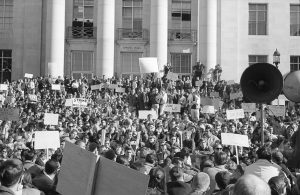
Sproul Plaza during the Free Speech Movement
Linda remained uninvolved in campus politics for her first two years at Cal, but that doesn’t mean she wasn’t paying attention to things happening around her.
“I remember one of the eeriest sights, when I really became aware of what a political hotbed Berkeley was,” she said of witnessing a stand-off outside her freshman dorm, just south of campus, “What turned out to be a SWAT team. They were all cops, just gathering, with shields and helmets and batons. I had never seen anything like that. It was extremely scary. Now if you saw that, you might just shrug and say, ‘Oh, something’s going on.’ But in 1965, it was a real phenomenon.” She didn’t have to be involved in a movement to understand that they were everywhere in Berkeley.
She moved to a new apartment on Ward Street at the beginning of the summer of ‘68—the summer of Robert Kennedy’s assassination, the Poor People’s Campaign, and Nixon’s nomination—and soon found herself spending a lot of time with the Roberts family, whose comings and goings via van and motorcycle she’d observed for weeks before discovering that one of the motorcyclists was her acquaintance, Mark Roberts. The small, green Roberts house was a peculiar one for a college town, and Linda was drawn to the fact that the Roberts family actually acted as a family unit. Linda had many friends, but they were just as independent as she; she didn’t yet have a family in Berkeley.
Zona Roberts and her sons were different. Zona zipped off to class on her motorcycle each morning, and there seemed to be a constant rotation of young people cycling in and out of the house.
“The whole family—they’re a very friendly family. Very, very friendly people. And just very unassuming. At the time, Zona was a student at Berkeley herself. Her husband had died a few years earlier. I don’t know how she did it financially. She was always on the edge, but somehow she managed,” Linda recalled.
She was attracted to the hum of energy radiating from the house and soon befriended Mark’s older brother Ed Roberts, the first wheelchair user admitted to UC Berkeley and the eventual father of the Disability Rights and Independent Living Movement. He suggested that she stop by Cowell Hospital and lend a hand. Cowell, while a fully functioning campus infirmary, also functioned as a dormitory of sorts for physically disabled students. It was unlike any program that existed anywhere else, and while Linda’s recollection of her early days there was hazy, she spent her summer on the northwest side of campus, doing odd jobs at Cowell.
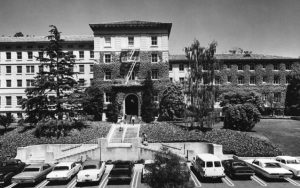
Cowell Hospital
As a woman, the help she could offer was limited—only men lived in Cowell at that point, and she recalled that “the men only had other young men working for them,” so she found herself doing laundry, typing up various documents, pushing wheelchair users around campus, and hauling enormous pots of chili and spaghetti across campus for Friday night dinners. Gender continued to define Linda’s relationship to Cowell and the budding Disability Rights Movement writ large; to her, the politics of the movement were for the boys.
“I never was interested in the political aspects of it,” she said, “It was just a byproduct as far as I was concerned. I even used to laugh at the guys. See, ‘the guys.’ It just happened to be that way.”
This disinterest was not from lack of care, but rather what Linda described as a naturally apolitical disposition. It wasn’t as if she wasn’t also interested in the pro-disability rights causes “the guys” were organizing for; of course she was. She spent her days working at Cowell and with the leaders of the Disability Rights Movement, albeit never in the context of their activism.
“This was really good for me,” she said of her proximity to their activism, “because it suited my level of political interest or awareness.” To Linda, her work was most significant when it was on the ground and person-to-person. Someone else could handle writing to the Chancellor.
“I had gone through the Cowell Hospital movement where people got organized and found their own strength and actually made their demands in such a way that the university responded to them and actually established a program just to serve the physically disabled,” she recalled, “That was very interesting.”
In the fall of 1968, the Cowell Program admitted its first female resident, and just as he had earlier in the summer, Ed Roberts encouraged Linda to go on up and introduce herself. Perhaps, Ed thought, Linda could serve as this new resident’s attendant, and help her with day-to-day tasks like bathing and getting dressed for class. Cathy Caulfield, Cowell’s first female resident, arrived in time for the fall semester, and sure enough, Linda became one of her attendants. At the same time, Linda recalled, the conversations that would serve as the foundation of the disability rights movement started picking up on the third floor of Cowell, where the program residents lived. Something was in the air.
But Linda was focused on her work. She had never been an attendant before, and the job was demanding. She deeply cared about being a good attendant for Cathy, and even beyond that, she cared about being a friend to her. So Cathy taught her how to change a urinary catheter, and how to dress and bathe her, and in turn, Linda learned how to be caring and gentle and composed. Her experience was typical; none of the attendants had formal training beyond what the people they worked for taught them. Cathy soon became deeply involved in the political organizing happening on the third floor, and she and Linda became good friends.

“I didn’t see myself as part of an attendant group because the rest were guys, and they worked for the guys, and my two friends and I worked for Cathy, ‘the woman,’” Linda said, referring to her two close friends who also worked as attendants. Her focus was Cathy, not finding community with other attendants or Cowell residents, and to her, that was just as well.
The next few years of Linda’s life track nicely alongside the development of the Disabled Students’ Program (DSP) and the Center for Independent Living (CIL)—she stopped taking classes during what would have been her senior year, and spent a lot of time with the organizers behind DSP and CIL as the programs swelled in size and scope. Still, though, movement politics were uninteresting to her. She cared about streamlining attendant referral services—everything was still word of mouth—and developing peer counseling services for disabled students, and helping the organizers accomplish other goals that they had, but she understood her role to be primarily administrative.
Linda Perotti never thought of herself as an activist. Her work was work, even if that work was also groundbreaking and life-changing and empowering for more people than she ever probably knew she could reach. The Sproul steps that she remembered so fondly have since witnessed many more movements, and many more generations of students who have benefitted from the activism—and semi-passive support—of Berkeley students that came before them. Linda may not have meant to join a movement, and maybe she would contend that she never actually did, but she certainly made a difference—for Cathy and the other Cowell residents, for herself, and for the generations of Berkeley students that followed her.
Preserving Spaces and Stories with Save Mount Diablo
by Samantha Ready
Samantha Ready is an Undergraduate Research Apprentice at the Oral History Center. She worked with Shanna Farrell and Amanda Tewes during the Spring ’21 semester to help them prepare for their upcoming oral history project celebrating Save Mount Diablo’s 50th anniversary.
From Samantha: My name is Samantha Ready (she/her) and I’m from Little Rock, Arkansas. I am currently a third-year at Cal double majoring in Ethnic Studies and Geography with a minor in Race and the Law. Some of my favorite pastimes are hiking, traveling, and listening to Johnny Cash.
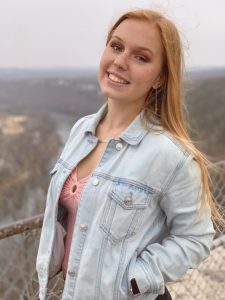
This semester, I had the privilege of joining the Oral History Center’s Save Mount Diablo Project as a background researcher under the mentorship of Shanna Farrell and Amanda Tewes. Despite growing up in the ‘Natural State’ of Arkansas, I didn’t learn much about environmental preservation. Coming into this research project, my personal definition of preservation was limited to the scope of society and culture. I’ve focused my studies on supporting and amplifying the perspective of marginalized communities, because they are often overshadowed by dominating narratives. Working on this project taught me about two important things that were missing from my definition of cultural preservation: land conservation and oral histories. Because I learned about the deeply rooted connections between environmental preservation and personal narratives, I now see clearly how important these facets are to the preservation of cultures and histories from all voices.
Save Mount Diablo (SMD) is a nationally accredited land trust organization and has been working to conserve the land around Mount Diablo in the East Bay since 1971. The preservation of natural land is a main goal of SMD, and has thus far been achieved through consistent advocacy, dedicated stewardship, thoughtful land-use planning, and educational programs. Mount Diablo’s biodiversity, historical and agricultural significance, and natural beauty are important to both the area’s general quality of life and natural resources. SMD works to provide ways for people to interact with the environment at Mount Diablo through recreational opportunities that consistently protect the region’s natural resources and open spaces, such as their Discover Diablo public hiking program, educational classes with local schools, and the annual Four Days Diablo backpacking trip through the mountain. Below are two maps of 2020 The Mount Diablo Regional Trail Map, which both feature the Diablo Trail that spans across the entire regional area. Of the 338,000 total acres shown between both maps, more than 120,000 acres have been preserved and protected thanks to Save Mount Diablo. Seth Adams, SMD’s Land Conservation Director, says that “No other map shows all of the Diablo area parks in a unified design and in regional context. The map illustrates what has been accomplished and what private lands still need to be protected.” (SMD website) The first map features Mount Diablo State Park and surrounding parks, and the second features Los Vaqueros and surrounding parks.
Mount Diablo & Surrounding Parks:
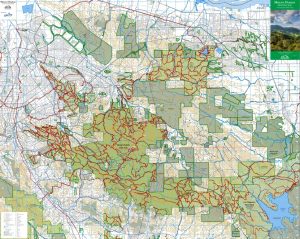
Los Vaqueros & Surrounding Parks:
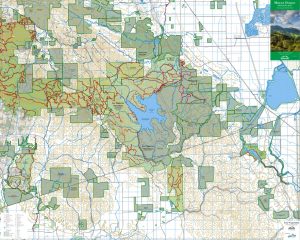
Image Credits: maps produced by Save Mount Diablo
In my research about Save Mount Diablo, it became apparent that working alongside surrounding community members -including SMD membershipSMD membership, various outside organizations, and political leaders/institutions- has been vital to maintaining their mission of preserving the environment. My first point of interest here was learning more about which communities and organizations SMD has worked with, how, and why. I immediately thought of Indigenous communities connected with Mount Diablo. Bev Ortiz, a Native American historian and SMD newsletter contributing author, wrote an article entitled “Mount Diablo as Myth and Reality: An Indian History Convoluted,“ in which she describes the mountain’s cultural and religious significance to Native Nations. Mount Diablo is meaningful for the Nations of the Miwok, Maidu (Nisenan), Ohlone (Chochenyo), Pomo, and Wintun Nations. Ortiz connected with members from these Native Nations in her work of preserving their cultural connections with Mount Diablo, from whom she learned about these connections, which included creation stories of several Nations. Creation stories are the original forms of oral history, and have helped preserve Indigenous cultures for thousands of years. Below is a map by Mount Diablo State Park of languages spoken by Native Americans from the region of Mount Diablo.
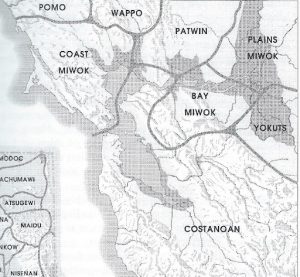
Image Credit: Mount Diablo State Park
Save Mount Diablo has often recognized Native cultural connections with Mount Diablo throughout its efforts to protect the mountain, such as in SMD Director of Land Programs Seth Adams’ timeline of the History of Mount Diablo, SMD’s stance to protect Tesla Park, and SMD Executive Director Ted Clement’s event to discuss SMD’s work with Indigenous communities to preserve cultural resources. Native American culture strongly connects with the environment, as they were the Earth’s first caretakers and the first to sustainably manage the world’s natural resources. Indigenous Nations around the world have maintained that stewardship of their ancestral homelands would be the first step to restoring their relationship with the land after colonization. In this sense, the inclusion of Native communities in environmental preservation would also aid in the preservation of their culture(s). To me, Save Mount Diablo’s work with Native communities thus far indicates their sincere recognition of how important the preservation of Native connections with Mount Diablo are to preserving the region’s land. Though there is definitely recognition, I remain curious as to the extent Indigenous communities are directly involved in SMD’s stewardship and conservation of Mount Diablo lands.
Another part of the community Save Mount Diablo works within is the political sphere. SMD has been heavily involved in, or at least taken stances on, several ballot measures throughout its50 years of fighting for environmental preservation. SMD also spends a lot of time tracking proposals by potential developers to ensure they follow the environmental rules and protections set by the California Environmental Quality Act (CEQA) of 1970. The main purpose of CEQA is to prevent and decrease environmental damage by developments and to allow a public decision-making process, which enables community members to discuss their concerns regarding development projects’s environmental effects. This work has led to SMD’s working with local political leaders and alliances with conservation networks in order to defend Urban Limit Lines (ULLs) against developers of preserved space in the Mount Diablo region. These ULLs preserve and protect open spaces, and are often threatened by developers, corporations, and some politicians. In their encouragement of public engagement with these issues, SMD provides email templates to send to local and state political leaders about issues at hand. Save Mount Diablo has been successful in these political methods of environmental preservation largely due to their active involvement and communication with outside persons, organizations, and institutions. Through its years of interactions with political representatives, public organizations, and parks districts, I wonder how, if at all, SMD’s standing as a private organization has affected the outcomes of these interactions. Additionally, I’m curious about how situational outside influences affected these interactions.
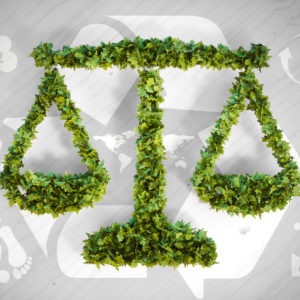
Image Credit: EnvironmentalScience.org
When learning about stories of the past, even those of organizations like Save Mount Diablo, it’s important to think about the perspective from which the story is being told. Learning about oral history played a big role in helping me realize that because of its practice to amplify and preserve individual voices so as to learn about their personal and lived experiences of historical occurrences. UC Berkeley’s Oral History Center (OHC) continues this mission across a variety of projects, including in this Save Mount Diablo Project. An ultimate goal of the SMD oral histories is to understand how the organization promotes a thoughtful relationship between people and the environment to inspire positive growth for the natural land and society as a whole. The background research I was able to contribute this semester barely scratched the surface of this story, and the rest lies in the stories soon to be told in the oral histories of Save Mount Diablo.
Learning about notable contributions of Save Mount Diablo to land conservation and environmental preservation taught me about how intersectional preservation is with most, if not all, facets of life. Not only do they work to conserve land that is sacred both biologically and culturally, SMD consistently provides recreational and educational resources for teaching and learning about the environment and the importance of preserving it. Now, it’s time for the preservation of Save Mount Diablo’s stories.
One Shot for Gold: Developing a Modern Mine in Northern California
by OHC Emeritus Historian/Interview Eleanor Herz Swent
An account of the creation of a modern, environmentally sensitive mine as told by the people who developed and worked it, from the University of Nevada Press Spring 2021 catalog.
In connection with this, Swent will be presenting her work as part of the American Society for Environmental History’s Environmental History Week. Her panel will be on Earth Day, and more information can be found here.
……………………………………………………………………………………..
As this was written, the Mars Rover Perseverance landed, thanks in part to research conducted at the mine in Napa County that was the subject of this book.
This is a different kind of oral history – not the life of a person, but of a mine – California’s most productive gold mine of the twentieth century. Between 1985 and 2002, the mine produced about 3.4 million ounces of gold, transforming the state’s poorest county and changing the industry around the world. OHC’s Knoxville/McLaughlin project, the basis for this book, comprised forty-eight interviews conducted over ten years.
In 1965, James William Wilder had a successful earth-moving and hauling business and decided to try mining. His research led him to buy the Manhattan mercury mine in the Knoxville District of Napa County. “We called it One Shot. If we don’t make it on this one, we’re out of the mining business.”
In 1974, Willa Baum, director of what is now the Oral History Center, was advisor for an Oakland neighborhood history project endowed by the NIH, and Eleanor “Lee” Swent was a volunteer, interviewing residents of the Fruitvale district and Chinatown. When Willa learned that Lee had spent most of her life living in mining towns, and that both her father and husband were mining engineers, it seemed that the time had finally come to document one of the most important aspects of California history – mining. In 1986, with the support of the American Institute of Mining, Metallurgical, and Petroleum Engineers [AIME], the Mining Society of America [MSA], and the Woman’s Auxiliary to the AIME [WAAIME], the oral history series on Western Mining was established, and from then until 2001, Lee conducted 46 full-length oral histories with significant figures in the industry. They were men, with three exceptions: Helen Henshaw, the wife of the president of Homestake Mining Company; Catherine Campbell, geologist, editor, and widow of Ian Campbell, California State Geologist and Director of the California Division of Mines and Geology; and Marian Lane, aka Winnie Ruth Judd, wife of a mine doctor.
In 1978, a young geologist working for Homestake Mining Company, California’s oldest corporation, explored the One Shot mercury mine. “It was just a joy to look at. It has to be one of the best exposed, zoned gold deposits that ever was. It was just a type example of the mercury-hot-springs-gold association; a classic example.”
It was accessible only from Lake County, at that time, the poorest in the state, with a median household income of $5,266 and a population of 19, 548. By 1989, when the gold mine was in production, the income had about quadrupled, to $21,794, and in 1990 the population was 50,631. With funding support from Homestake, a community college branch was subsidized to train local workers, a hospital expanded its services, telephone and electric utility service was extended, and roads were paved. Many of these improvements were lasting benefits to the county.
The life of the mine was projected to be about twenty years, and most of the key players were available for interviews. It was a rare opportunity to document the discovery, development, and reclamation of a mine while it was happening. In 1991, the Knoxville District/McLaughlin Mine oral history project was launched.
Between then and 2005, forty-eight interviews, from two to seventeen hours long, were conducted with the owner of the One Shot Mine; Homestake officials and a wide range of employees; supervisors and planners from Napa, Lake, and Yolo counties; the Lake County school superintendent, local historians, mercury miners, merchants, and ranchers, as well as some of the most vocal opponents of the mine. Their voices help to tell the story of the mine and a changed community.
An engineer from New Zealand was manager for the construction. “This was the biggest nonunion construction project that had ever been done in California. It was thirty-odd miles long and we did 3 million man-hours. We engineered the dickens out of everything.” A rancher’s wife appreciated her job as a mine surveyor. ”I’ve learned invaluable stuff on the computers that I had never had any experience with before.”
“One Shot for Gold” documents the effort to win public support and to obtain an unprecedented number of 327 permits from the federal, state, regional, and local agencies that had jurisdiction. Homestake engineers tell of their research from Finland to South Africa to develop the method of high-pressure oxidation to recover gold from ore without polluting air or water; it has now been copied around the world.
The mine was named for Donald Hamilton McLaughlin, chairman emeritus of Homestake and a regent of the University of California. In 1961, his wife, Sylvia Cranmer McLaughlin, founded Save San Francisco Bay, one of the first grassroots environmental organizations, that sparked national awareness and led to the first Earth Day, celebrated in San Francisco in 1974. This movement forced Homestake to incorporate environmental protection into its business model. From the beginning, plans for the mine included reclamation as the Donald and Sylvia Nature Reserve, part of the University of California Natural Reserve System. He died at the age of 93 on December 31, 1984, and Sylvia McLaughlin dedicated the mine to him in a ceremony on Saturday, September 28, 1985. The natural reserve named for them is a fitting coda to the story of a modern mine: extracting one precious resource, gold, and preserving another, the natural environment, its air and water.
In 2001, the mine geologist recalled, “NASA Ames research showed up at the door to look at samples of rock from our hot springs terraces that contained fossilized bacterial remains, evidence for the most primitive live on earth, to think through how landers on Mars would go about sampling and looking for evidence of life.”
“One Shot for Gold” begins with the mercury mine at Knoxville and ends with the Donald and Sylvia McLaughlin Nature Reserve. On February 11, 2021, the director of the reserve wrote, “Since around 2010, we’ve had a team from NASA and biogeochemists from various universities working on understanding the bacteria that live in geologic water deep inside serpentine rock, and how those studies can inform exobiologists where to look for life on other celestial bodies.”
As this was written, the astrobiology Rover Perseverance landed on Mars, ready to hunt for signs of life like those preserved at the depths of the Mclaughlin mine.
OHC Director’s Column for March 2021 features Guest Contributor Shanna Farrell
The Importance of Rapport
by Shanna Farrell, March 2021 Guest Contributor
A smile. A nod. A set of shoulders relaxing. A story seldom told. A handwritten note expressing gratitude. These are all examples of rapport, the genuine human connection forged between an interviewer and a narrator.
Sometimes, when you’re lucky, it happens naturally. There’s an ease between you and your narrator, a kind of simpatico that makes you feel like you’ve known each other for a long time. But in most cases, rapport needs to be earned, built slowly over time in a myriad of ways. Perhaps you have a shared experience, like growing up around horses. Perhaps you share interests, like a favorite author or movie or hike. Perhaps you went to the same college. Perhaps you have nothing in common, but you listen to each other talk without interrupting. Perhaps you look at each other in the eye, and are always on time, and after a while, you become sympathetic to one another, despite your differences.
Whenever we talk about oral history interviewing, we talk about rapport. It can come in many shapes and sizes. We discuss how to cultivate it during our Introductory Workshop and Advanced Summer Institute, trying to impress upon those who are there to learn from us how it can impact an oral history. Though there are no magic tricks for creating it with someone―aside from treating them as you’d like to be treated―it’s one of the most important elements of an interview. It affects so many things: the stories told; language used to describe something; the openness a narrator feels; how comfortable an interviewer is asking tough questions; the willingness to shed performative layers; the ability to bear witness to a person’s experiences.
I’ve been in situations where I have good rapport with a narrator. It’s something I’ve felt innately, through all of those nonverbal cues. It showed up in the interview, too, evident in the honesty of an answer and inclination to dig a little deeper, reflect a bit further. You can hear it in the recording, read it in the transcript, see in the tears that are shed on camera. These are the moments that I love―the ones filled with a common humanity―and keep me engaged in the oral history process.
And then there are times that I don’t have rapport with a narrator. The times I’ve used a word―like “strategy”―that I think is innocuous, but is loaded for them. Times that I’ve expressed that I, too, lived in Brooklyn, but it’s not enough to bridge our gap. The times that no matter how much I smile or make eye contact or nod that I can’t get them to open up, to lower the walls they’ve built to protect themselves. But I never stop trying. These are the moments that make me want to keep going, keep working.
In the time before COVID-19, it was much easier to read these situations. When I was in the same room as the person whom I was interviewing, I could usually tell if something was or wasn’t working, our interactions not flattened by a screen. But now that we’re a year into the pandemic, cultivating rapport is more difficult. When we’re so physically distant from our narrators. We might meet them first over email or the phone, maybe even through a letter. Our first opportunity to smile at them may come right before the interview begins as we’re double checking the settings on our computers. Or we may never have that chance, particularly when the interview is done over the phone. Silences may be misinterpreted, nods go unnoticed, cues from our bodies unheeded.

To be clear, I think it’s important to keep interviewing during this time. We need to document our experiences and keep reflecting on our lives. It’s also necessary that the minutiae of the current moment be mirrored in the archives, as our relationship with technology and distance change, and that we carry on with this work using the tools we have to get through these difficult times in the best way we know how. To illustrate how oral history and interview dynamics has evolved and adapted, what’s been lost and gained.
I’ve learned to lean more heavily on my pre-interviews, the conversations that I have with narrators in advance of the oral history sessions. These are generally meant to go over logistics, inform someone of their rights, go over topics and themes to address in the interview, and schedule sessions. While all of these usual rules still apply, I have become more sensitive to how this initial contact with them can build rapport from afar. I try to laugh more if I find something funny because they might not be able to see me smile. I’m more forthcoming about myself and the things we have in common because they might not be able to see me nod. I give them space to talk, still careful not to interrupt or cut them off, because they might not understand why I’m silent for a few beats during the interview. Above all, I don’t rush these calls. I talk my time getting to know them, answering their questions, and looking for ways to connect. I mail paperwork or email interview outlines when I say I will, using the little things I can control to build trust.
Remote interviewing may never be the same as sitting down face to face with someone, but rapport remains equally important. It’s in the relationships we build with our narrators that allow us to best honor their lives, making sure their legacy lives on long after they do, in their own words. Human connection means more now than ever before.
Shanna Farrell will be teaching about rapport and interviewing during our Advanced Oral History Institute, August 9–13. As last year, this year’s interactive institute is remote and draws attendees from all over the world.